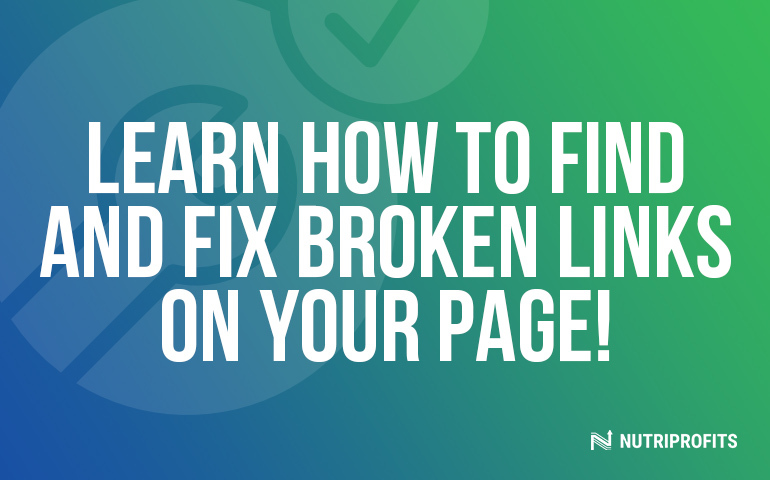Imagine if someone is browsing through an affiliate marketer’s website, and they find a link that interests them. They click on the link, but there’s one problem. The link is broken.
It’s highly frustrating when someone clicks on a link but ends up on a 404 error page. Many consumers will often leave when they come across a broken link. Departing consumers means fewer conversions and less money.
To earn more conversions and money in affiliate marketing, let’s learn how to find and fix broken links on your page!
What Are Broken Links?
If you’ve ever clicked on a link and ended up on an error page instead of the page the link intended to go to, that link is broken.
Users can ’t find or access broken links for various reasons. They’re also called dead links or link rots. When a user clicks on a broken link, the website they were on takes them to an error page.
Some examples of broken link error codes are:
- 400 Bad Request: The host website doesn’t understand the URL.
- 404 Page Not Found: The page doesn’t exist on a server.
- Bad Code: The HTTP response code is invalid, or the server response violates the HTTP spec.
- Bad Host: The host name is invalid, or the server with that name doesn’t exist/is unreachable.
- Bad URL: The URL is deformed.
- Empty: The host server has no content and no response code.
- Reset: The host server drops connections from being too busy or mis-configured.
- Timeout: The HTTP requests timed out all the time during the link check.
Why would a link be broken? There are many reasons, but some common ones are:
- The affiliate marketer entered the URL incorrectly.
- The website’s URL structure changed without a redirect.
- The external site is unavailable, offline, or moved permanently.
- Links to some content have been moved or deleted.
- There are broken elements within the page.
- Firewalls or other geolocation restrictions don’t allow outside access.
Why Is It Important to Fix Them?
Nobody likes to encounter a broken link. When a consumer encounters one, they’re most likely to leave the affiliate marketer’s website. That’s not good for anyone involved.
Here’s why fixing broken links is vital for affiliate marketers.
Bettering User Experience
It doesn’t take much for a consumer to leave. If the affiliate marketer’s website loads too slowly, doesn’t support mobile shopping, or is too difficult to navigate, many consumers will go elsewhere.
Consumers will especially leave if they encounter a 404 error page on the affiliate marketer’s website. Luckily, it’s easy to fix broken links by redirecting them to proper pages, using 301 or 302 redirects, or removing them.
Boosting SEO Rankings
SEO (search engine optimization) improves the quality and quantity of traffic to a website or web page from search engines. More traffic for the affiliate marketer means more conversions and money, and broken links will hinder them.
Search engines may not punish the affiliate marketer for having a broken link, the marketer will have a harder time earning conversions. That’s because search engine spiders have to crawl a website and particular pages.
For example, imagine if the affiliate marketer changes their FAQ page’s URL, but the links to the old URL still exist on other web pages. That means search engine spiders will go to those broken links as they crawl the website.
When the spiders realize those links are broken, they’ll leave and isolate the new URL. Isolation makes it harder for the new URL to get indexed and appear in search engines.
Broken links also lead to high bounce rates, which are terrible for SEO and conversion ranks!
Improving Conversion Rates
A website filled with broken links is a recipe for poor conversion rates. Consumers find it frustrating to click on a link only to be redirected to an error page. As a result, they’ll leave, and the affiliate marketer will miss out on great conversion rates and money.
Sometimes, a 404 page can direct consumers to the affiliate marketer’s homepage or other relevant pages. Sometimes, the consumers will browse the website some more to find the link they were looking for. Usually, consumers will give up and exit the affiliate marketer’s website.
To improve conversion rates and earn more money, it’s best to fix broken links to ensure a stress-free shopping experience. Otherwise, consumers will go elsewhere, and the affiliate marketer will miss out on great conversion rates and money.
Ensuring a Trustworthy Website
Suppose a consumer is browsing the affiliate marketer’s website, and they click on a link. That link leads them to an error page, and the consumer loses trust in the affiliate marketer.
Sometimes, a couple of broken links won’t mean much to consumers, but repeated broken links will kill any credibility the affiliate marketer has left.
Ensuring a trustworthy website means fixing broken links and redirecting them to relevant pages to whatever consumers are looking for.
Ways to Fix It:
Now that the affiliate marketer knows what broken links are and why it’s crucial to fix them, it’s time to learn how to put that into practice. There are several methods of finding and fixing broken links, and this article will show some useful ones the affiliate marketer can use.
Method One: Finding Broken Links
Scrolling through a website to find broken links can take all day. Luckily, there are websites that will help the affiliate marketer find broken links that need fixing.
Certain websites have SEO audit tools to find broken links, and they’re easy to use and powerful. The affiliate marketer needs to set up a new project and type/paste their site’s address. Then, the audit tool will scan the affiliate marketer’s website. This can take up to 20 minutes depending on the website’s size.
After the scanning is complete, the affiliate marketer can click on the reports section, where they can see a list of all the 404 errors on their website.
There are also free desktop softwares for finding broken links. Some work on Windows, macOS, and Ubuntu. All the affiliate marketer needs to do is download and install whatever program is available on their computer.
After downloading and installing, the affiliate marketer needs to add their site’s URL to a box at the top and click the start button. Then, they can use a Response Codes option to filter out 404 pages and use the Inlinks feature at the bottom to find those links.
Method Two: Fixing Broken Links
After finding broken links, it’s time for the affiliate marketer to fix them. There are many ways to fix broken links, but the two most common ways are replacing and removing them.
One way to fix a broken link is by replacing it with a live link. This can either take five minutes or five weeks, depending on the amount of broken links. If the affiliate marketer is unsure of what the link used to point to, they can always throw it into the Wayback Machine.
If replacing broken links sounds like hard work, then the affiliate marketer can remove them. Again, this can either take five minutes or five weeks, depending on the amount of broken links.
Method Three: Finding Broken Backlinks
For those who don’t know, backlinks link from other websites to the affiliate marketer’s website. When a backlink is broken, there are usually two reasons:
- The affiliate marketer deleted or moved a page with existing backlinks.
- The linking site made a mistake when linking to the affiliate marketer.
Luckily, there are websites to find broken backlinks. All the affiliate marketer needs to do is go to a site explorer, enter their website’s address, go to the pages section, click best by links, and the site will add a “404 not found” HTTP response filter.
These websites will inform the affiliate marketer how many referring domains a broken page has.
Method Four: Fixing Broken Backlinks
Some might say the affiliate marketer has no control over links outside their website, but there are still ways to fix broken backlinks.
For starters, the affiliate marketer can reach out to the linking website and request a fix; maybe the linking website made a mistake it can easily fix.
The affiliate marketer can also redirect a broken page to a new location. All they need to do is find the new page location and install a redirect. It also helps to redirect a broken page to another relevant page on the affiliate marketer’s website.
Occasionally, the affiliate marketer has no choice but to leave the page as a 404. However, they can still use the Wayback Machine to see an archived copy of it.
If there’s no archive, some websites will help with that. All the affiliate marketer needs to do is go to the site explorer, enter the broken URL, and go to the backlinks. Then, they can use a search engine to see if the page was deleted or moved.
If the search engine finds the broken page at a different URL, then the affiliate marketer can redirect the old page to the new URL via a 301 redirect. If not, then they’ll have to replace or recreate the page.
Conclusion
Without doubt, it’s frustrating to click on a link only to be redirected to an error page. Finding and fixing broken links is crucial for bettering user experience, boosting SEO rankings, improving conversion rates, and ensuring a trustworthy website.





.jpg)

-1-1.jpg)